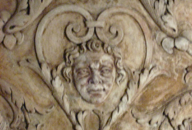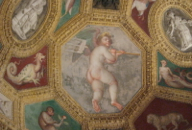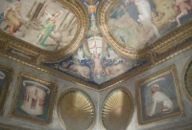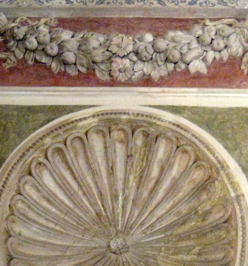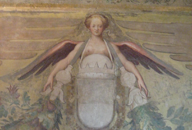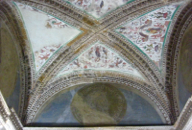Garden palace
palazzo giardino
Sabbioneta
Lombardy, Italy
Europe
November 14-15, 2008


Garden palace
palazzo giardino
Sabbioneta
Lombardy, Italy
Europe
November 14-15, 2008




The Palazzo Giardino, or Garden Palace, built as a private palace for Duke Vespasiano Gonzaga and his noble guests, providing them with the space to amuse themselves, relax, read, rest, listen to music, and be at peace in the country. The building is modest in scale, built c. 1582, and was once painted in geometrical motifs of faux marble. Today, the exterior is painted white with carved oak trim, the only clue to the prestige of the building being the marble surrounds of the door. The interior, however, reveals the opulence of the mannerist fashion, which only hints at the luxury and companionable fun which must have occurred within these walls. Bernardo Campi, an artist from Cremona and his “school” created the wall and ceiling frescoes beginning in 1582.
PHOTOS: Left Column: 1. Plasterwork on the barrel vault of the Corridor of Orpheus, painted by Carlo Urbino’s pupil, a principal assistant of Bernardo Campi. 2. Studiolo of Enea, Vespasiano Gonzaga’s private study. The ceiling details include panels framed in plasterwork modeled by Fornarino and gilded by Martire Presenti. Painted by Bernardo Campi, putti bear attributes of some of the gods. Smaller panels have exotic animals painted on the. 3. Room of the Myths, showing two of the four paintings, plus additional detailing. 4. Room of the Myths, the ceiling detail includes four paintings by Bernardino Campi. The one illustrated is Dedalo and Icaro or Dedalus and Icarus. Center, Top: The central wall in the Chamber of the Three Graces which has a painting of the same subject matter. The tiny and beautiful room is entirely decorated with grotesques. It was probably used as a powder room for the ladies. Center, Bottom: Plasterwork detail: Room of Mirrors, the main room in the Garden Palace reserved as a music room and ball room. Marble busts would have been set on the sconces in font of these plasterwork details. Right Column: 1. Plasterwork on the barrel vault of the Corridor of Orpheus, painted by Carlo Urbino’s pupil, a principal assistant of Bernardo Campi. 2. Studiolo of Enea, Vespasiano Gonzaga’s private study. The ceiling details include panels framed in plaster work modeled by Fornarino and gilded by Martire Presenti. Painted by Bernardo Campi, putti bear attributes of some of the gods. Smaller panels have exotic animals painted on them. 3. Room of Philemon and Bauci, taken from the Metamorphoses by Ovid. Wall detail: A winged figure holding the ducal coat of arms. 4. Ceiling detail, Room of the Caesars. In the lunette is a portrait of Julius Caesar.

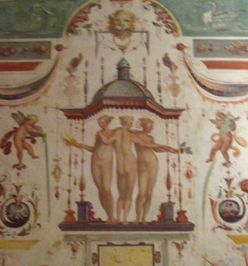
EMBELLISHED
